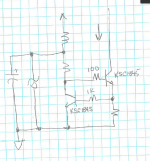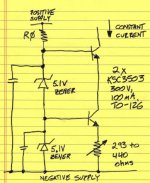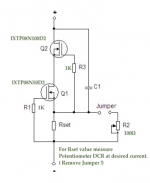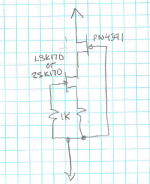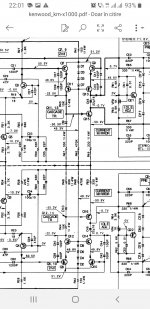@artosalo - were you using a cascode on the LM317, or just the part by itself?
From what I've been reading, I am thinking of using cascoded DN2540s. My LTSpice simulation is showing 0.02uA variation on 10mA with a 1KHz 1v signal applied. This increases to 0.36uA at 20Khz and 1.8 uA at 100KHz.
I also simulated the TL431 circuit and this showed 0.3uA, 0.68uA and 3uA variation under the same conditions. So this maintains its performance better at higher frequencies, but is still worse than the DN2540s.
I'm sure these results are optimistic and I really don't know which models are more accurate, but the results from the DN2540s seem encouraging.
From what I've been reading, I am thinking of using cascoded DN2540s. My LTSpice simulation is showing 0.02uA variation on 10mA with a 1KHz 1v signal applied. This increases to 0.36uA at 20Khz and 1.8 uA at 100KHz.
I also simulated the TL431 circuit and this showed 0.3uA, 0.68uA and 3uA variation under the same conditions. So this maintains its performance better at higher frequencies, but is still worse than the DN2540s.
I'm sure these results are optimistic and I really don't know which models are more accurate, but the results from the DN2540s seem encouraging.
Attached the schematic where I used the LM317 as a CCS, but this turned out to be too noisy.
The main reasons I chose TL431/NPN combination was:
A cascode of DN2540 may obviously have higher dynamic resistance, but I don't see it necessary to use two high voltage DMOS FETs
in this kind of low voltage (about 10 V) circuit.
Obviously there are different applications where the use of cascoded DN2540 is justified.
The main reasons I chose TL431/NPN combination was:
- no need for negative supply for CCS
- essentially lower noise
- more than sufficient dynamic resistance
A cascode of DN2540 may obviously have higher dynamic resistance, but I don't see it necessary to use two high voltage DMOS FETs
in this kind of low voltage (about 10 V) circuit.
Obviously there are different applications where the use of cascoded DN2540 is justified.
Attachments
Member
Joined 2009
Paid Member
Why not use a choke in the tail of your LTP ?
A choke will behave as a CCS, with low enough DCR it requires very little voltage headroom too.
A choke will behave as a CCS, with low enough DCR it requires very little voltage headroom too.
Not a bad choice. Slight sound improvement with IXYS parts. (IXTP08N50D2 / IXTP08N100D2) Just a personal preference , not saying it's technically better than anybody else's suggestion here.From what I've been reading, I am thinking of using cascoded DN2540s.
The drawing is from a K&K audio Kit . C1 = 68pF and is only used on plate loads where bandwidth limiting is required to stop oscillation. Otherwise , not used.
Very handy to have a few of these in a drawer , espcially with the high voltage part on top they can be thrown just about anywhere you'll need for breadboarding .
Attachments
Last edited:
Bsp...bss transistors are perfect for the job. Choose 1kohm source resistor for 1mA if you're using ecc83 differential at 500uA each. 100ohms for about 5.5mA.... https://www.diyaudio.com/community/threads/teardrop-headphones-amplifier.315827/#post-5463972
Attachments
This one is a true 2-terminal current sink. the PN4391 cascode fet limits the voltage across the 2SL/LSK170, and keeps the gate current out of the exponential region. . One k might be a little much of a stopper value for the bottom side fet, but it certainly won't squeal with that value - adjust to taste...
Attachments
Mr. Johnson - I agree on the cascode gate fet connection - I was in a hurry and overlooked that detail.
Member
Joined 2009
Paid Member
yes indeed, but some people do like to make things without sand - the ss current sink is the best technical solution of course, but there's a reason we sometimes want to build only with tubes.That would be a big, big, big choke...
Hammond make some low cost 8mA 150H chokes which will give a tail resistance of 18k + 3k DCR = 21k at 20Hz and much higher impedances at higher frequencies. Not anywhere as high an impedance as a SS current sink but where to draw the line in terms of technical specifications - we could add SS current mirrors to the LTP too. I've seen that done and reported on this forum, and great performance obtained.
With the big, big choke, I would also worry about stray capacitance - it may cease being a choke at a relatively low frequency.
Thanks for all the great ideas. A choke won't work for me because I want to have adjustability to dial in the best current for SQ. Also don't have the space for something like that.
Is there any consensus between BJTs vs FETs?
I'm planning to use the same design for three current sources in my line stage (based on Allen Wright's RTP3D). This is what I currently have laid out on my PCBs.

Is there any consensus between BJTs vs FETs?
I'm planning to use the same design for three current sources in my line stage (based on Allen Wright's RTP3D). This is what I currently have laid out on my PCBs.
Since DN2450 is a niche device made by only one semiconductor manufacturer, it might be wise to buy more than you need right now. In case they go out of stock, or get cancelled, or get switched to a new weird package, at some inconvenient moment in the future.
I'd suggest checking how much money it costs to buy one of the input vacuum tubes, then spending that amount of money to purchase a supply of spare DN2450 devices.
I'd suggest checking how much money it costs to buy one of the input vacuum tubes, then spending that amount of money to purchase a supply of spare DN2450 devices.
- Home
- Amplifiers
- Tubes / Valves
- Low noise current sink for LTP

